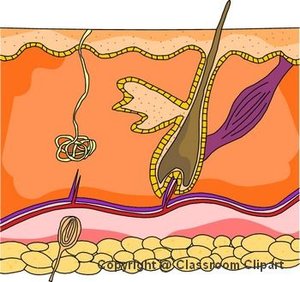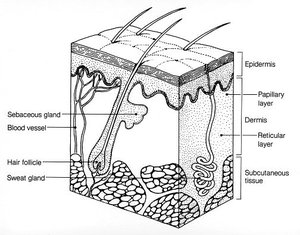Skin
|
|
Skin is an organ of the integumentary system; which is composed of a layer of tissues that protect underlying muscles and organs. Skin is used for insulation, vitamin D production, sensation, and excretion (through sweat).
Skin on creatures regularly subjected to sunlight have pigmentation which absorbs the potentially dangerous radiation contained therein. Human skin pigmentation varies across populations in a visually dramatic manner. This has sometimes led to the classification of people(s) on the basis of skin color. See the article on human skin color for more information.
Mammalian skin often contains hairs, which in sufficient density is called fur. The hair mainly serves to augment the insulation the skin provides. On some animals, the skin is very hard and thick and can be processed to create leather.
Damaged skin will try to heal by forming scar tissue, often giving rise to discoloration and depigmentation of the skin.
The skin is often known as "the largest organ in the human body": this applies to the exterior surface, as it covers the body, appearing to have the largest surface area of all the organs. Moreover, it applies to weight, as it weighs more than any single internal organ. For the average adult homo sapiens, it has a surface area of between 1.5-2.0 square meters.
The skin on a person's face is seen by people that person interacts with. For some people, therefore, facial skincare is of particular importance, and they often use cosmetics to deal with the appearance of the face and condition of the skin, such as those for pore control and blackhead cleansing.
| Contents |
Layers
Skin is composed of the epidermis and the dermis. Below these layers lies the hypodermis, which is not usually classified as a layer of skin.
The outermost epidermis is made up of stratified squamous epithelium with an underlying basement membrane. It contains no blood vessels, and is nourished by diffusion from the dermis. The main type of cells which make up the epidermis are keratinocytes, with melanocytes and Langerhans cells also present. The epidermis can be further subdivided into the following strata (beginning with the outermost layer): corneum, lucidum, granulosum, spinosum, basale. Cells are formed through mitosis at the innermost layers. They move up the strata changing shape and composition as they differentiate and become filled with keratin. They eventually reach the corneum and become sloughed off. This process is called keratinization and takes place within about 30 days.
Blood capillaries are found beneath the epidermis, and are linked to an arteriole and a venule. Arterial shunt vessels may bypass the network in ears, the nose and fingertips.
The dermis lies below the epidermis and contains a number of structures including blood vessels, nerves, hair follicles, smooth muscle, glands and lymphatic tissue. It is made up of dense connective tissue - collagen, elastin and reticular fibres are present. Erector muscles, attached between the hair papilla and epidermis, can contract, resulting in the hair fiber pulled upright and consequentially goose bumps. The main cell types are fibroblasts, adipocytes (fat storage) and macrophages. Sebaceous glands are exocrine glands which produce sebum, a mixture of lipids and waxy substances: lubrication, water-proofing, softening and anti bactericidal actions are among the many functions of sebum. Sweat glands open up via a duct onto the skin by a pore.
The dermis can be split into the papillary and reticular layers. The papillary layer is outermost and extends into the dermis to supply it with vessels. It is composed of loosely arranged fibers. Papillary ridges make up the lines of the hands. The reticular layer is more dense and is continuous with the hypodermis. It contains the bulk of the structures (such as sweat glands). The reticular layer is composed of irregularly arranged fibers and resists stretching.
The hypodermis is not part of the skin, and lies below the dermis. Its purpose is to attach the skin to underlying bone and muscle as well as supplying it with blood vessels and nerves. It is made up of loose connective tissue and elastin. The main cell types are fibroblasts, macrophages and adipocytes (the hypodermis contains 50% of body fat). Fat serves as padding and insulation for the body.
Types
Skin can be dividided into thick and thin types. Thick skin is present on the soles of the feet and the palms of the hands. It has a larger stratum corneum with a higher keratin content. Thick skin does not grow hair; its purpose is to help grip. Thin skin is present on the bulk of the body and has a smaller stratum corneum and fewer papillae ridges. It has hair and is softer and more elastic.Functions
- Protection: an anatomical barrier between the internal and external environment in bodily defense; Langerhans cells in the skin are part of the adaptive immune system
- Sensation: enables irritability
- Storage: acts as a storage center for lipids and water, as well as a means of synthesis of vitamin D by action of UV on certain parts of the skin.
- Absorption: Oxygen, nitrogen and carbon dioxide can diffuse into the epidermis in small amounts.
- Excretion: The concentration of urea is 1/130th than that of urine. Excretion by sweating is at most a secondary function to temperature regulation.
- Heat regulation: The skin contains sebaceous glands and smooth arrector pili muscles.
Hygiene
The skin must be regularly cleaned. Unless enough care is taken it will become cracked or inflamed. The unclean skin favors the development of pathogenic organisms. The constantly peeling off dead cells of the epidermis mix with the secretions of the sweat and sebaceous glands and the dust found on the skin to form a filthy layer on its surface. If not washed away the dirt begins to decompose emitting unpleasant foul smell. Functions of the skin are disturbed when dirty and it becomes more easily damaged. The release of antibacterial compounds decreases. Dirty skin is more prone to develop infections. Cosmetics should be used carefully because these may cause allergic reactions. Each season requires suitable clothing in order to facilitate the evaporation of the sweat. Sunlight, water and air play an important role in keeping the skin healthy.
Aging and disease
As skin ages, it becomes thinner and more easily damaged. Intensifying this effect is the decreasing ability of skin to heal itself. Skin sagging is caused by the fall in elasticity. Skin also receives less blood flow and lower gland activity.
In medicine, the branch concerned with the skin is called dermatology.
The skin is subject to constant attack from without, and so can be afflicted by numerous ailments, such as:
Tumors:
- Benign tumors of the skin: Squamous cell papilloma
- Skin cancer
Others:
- Rashes
- Blisters
- Acne
- Keratosis pilaris
- Fungal infections such as athlete's foot
- microbial infections.
- calcinosis cutis
- ulcer
- list of skin diseases
See also
Anatomy Clipart and Pictures
- Clip Art (https://classroomclipart.com)
- Anatomy Clip Art (http://classroomclipart.com/cgi-bin/kids/imageFolio.cgi?direct=Anatomy)
- Anatomy Clip Art (http://classroomclipart.com/cgi-bin/kids/imageFolio.cgi?direct=Clipart/Anatomy)
- Anatomy Animations (http://classroomclipart.com/cgi-bin/kids/imageFolio.cgi?direct=Animations/Anatomy)
- Anatomy Illustrations (http://classroomclipart.com/cgi-bin/kids/imageFolio.cgi?direct=Illustrations/Anatomy)
| Integumentary system |
| Skin - Sweat glands - Hair - Nails |
| Skin |
| Epidermis (Stratum corneum, Stratum lucidum, Stratum granulosum, Stratum spinosum, Stratum germinativum/basale) |
| Dermis - Subcutis |


